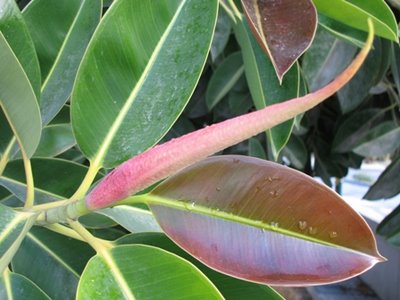Ficus Plants for Indoors
By Jos Van Hage
 Ornamental plants from the Ficus family are a popular choice for indoor plants.
Ornamental plants from the Ficus family are a popular choice for indoor plants.
The most common varieties that are readily available and grow well in an indoor environment are the Ficus benjamina (weeping fig), Ficus elastica (rubber plant, Ficus lyrata (fiddleleaf fig) and the Ficus pumila (creeping fig).
The weeping fig makes a beautiful floor plant as it grows into a tree form with pretty white bark and arching branches that have shiny green leaves. It can grow 20 feet tall if it has the room.
The rubber plant also is a floor plant. It has large, thick 10 inch long and 5 inch wide leaves that start off pink and mature into dark green. ( as shown in photo)
Fiddleleaf fig makes a nice floor plant as it can grow quite large and has a similar growth pattern to the rubber plant. The leaves are huge growing 15 inches long and 10 inches wide. They are fiddle shaped and are dark green and glossy.
The creeping fig is different from the other figs because it is a vine and creeps along the ground and cascade down from a hanging basket. The heart shaped leaves are tiny and delicate and the plant grows quickly.
All of these grow well in bright, indirect light such as a south, east, or west window.
When to give the plant water is important as this is when problems can occur, too much or too little water can cause the leafs to drop. You should feel the soil first before you give the plant water. When the top 3-5 centimeters of soil feels dry give the plant a thorough water using room temperature water and then check the plant 15 minutes later and if there is still water in the saucer throw it out as you do not want the plants roots to sit in water.
Drafts, dry heat, and sudden temperature or light changes can also cause the plant to drop its leaves so it’s important to find the ideal spot. This time of year when the furnace is on and the air in the house becomes drier and plants can loose their leafs also. To help prevent this you can create a mini climate by placing plants on a humidity tray. A humidity tray is simple to make and requires only a plant saucer and some rocks. Choose a saucer that is 2-3 inches larger than the bottom of the pot size. Fill it with a layer of rock and then pour water in the saucer so that it is level with the top layer of rocks. Finally place the plant on top of the rocks making sure that bottom of the pot is not sitting in water but just on top of it. This creates humidity around the plant because the water in the rock filled saucer evaporates around the plant. If you have some smaller plants you can place a few of them on one tray.
Ficus plants enjoy a high humidity so this would be a good solution to a low humidity problem. Fertilize plants with an all purpose 20-20-20 fertilizer every 4 weeks in the spring/summer and every 8-10 weeks during the fall/winter months when the plant goes into a semi-dormant state. Ficus plants only need to be transplanted when they become root bound and can be trimmed into shape at any time. They make ideal house plants.
-Jos
Jos Van Hage owns and operates two Art Knapp Garden Centres in the Prince George area:
- Highway 97 North at Northwood Pulpmill Road
- Highway 16 West at Kimball Road
Previous Story - Next Story
Return to Home








